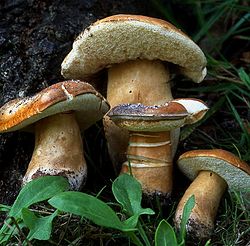Top Qs
Timeline
Chat
Perspective
Gyroporus castaneus
Species of fungus From Wikipedia, the free encyclopedia
Remove ads
Gyroporus castaneus, commonly known as the chestnut bolete,[1] is a small, white-pored mushroom in the Gyroporaceae of order Boletales. It has a brown cap, and is usually found with oak trees. It differs from the true boletes in that the spores are a pale straw colour.
Remove ads
Taxonomy
The species was described initially by the French mycologist Jean Baptiste François Pierre Bulliard (1742–1792). Formerly a member of the family Paxillaceae, research now places this mushroom in Gyroporaceae. Gyroporus means 'having round pores', and castaneus is a reference to the chestnut colouration.
Description
The cap is from 3 to 10 cm in diameter, and pale to rusty brown in colour,[1] which becomes darker with age. The stem is a similar colour,[1] although it may be lighter at the apex. If the stem is cut vertically, it is usual to find several cavities of differing sizes inside. Both the cap and the stem have a tendency to crack or split in dry periods, or with age. The pores are small and white, yellowing with age,[1] and are not attached to the stem. They darken slightly when pressed. The tubes are also whitish, and the spore print is pale yellow to straw. The flesh is firm,[2] and does not change colour on cutting.[1]
Remove ads
Distribution and habitat
The mushroom is found occasionally in Britain and throughout continental Europe, as well as eastern North America, but it is rare in western North America.[1] It grows in small groups, or singly, in an ectomycorrhizal relationship with oaks (Quercus). It prefers acid and sandy soils, and fruits from summer to autumn. In New Zealand, it is found in association with Leptospermum.[3] In Asia, it has been recorded from Taiwan.[4]
Gyroporus castaneus has been included in the Moscow Oblast's and the Russian Federation's Red Book and several other countries' Red Lists, including those of Norway and Montenegro.[5][6][7]
Edibility
Gyroporus castaneus is edible and highly regarded by most authors.[1][8] In 1987, Marcel Bon regarded it as suspect.[9] There is also reportedly a poisonous strain of this mushroom in coastal Portugal.[10]
See also
References
External links
Wikiwand - on
Seamless Wikipedia browsing. On steroids.
Remove ads


